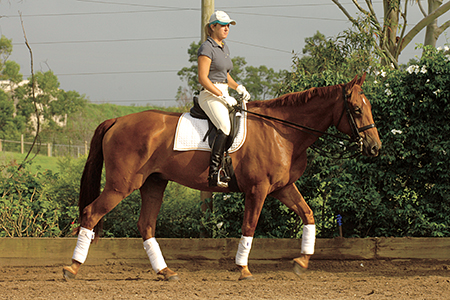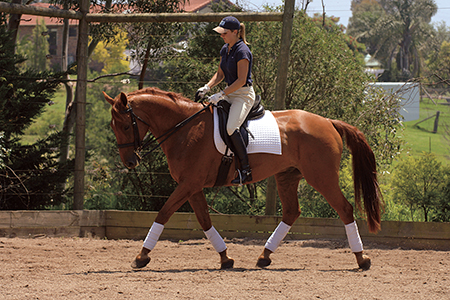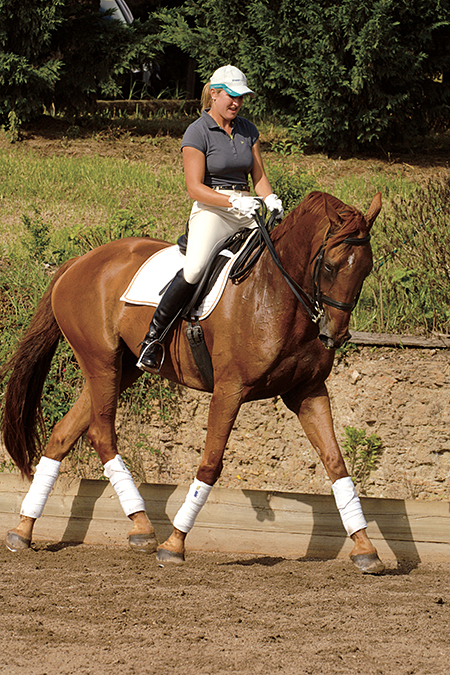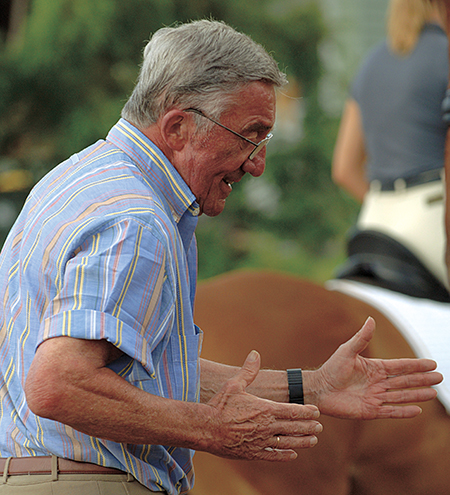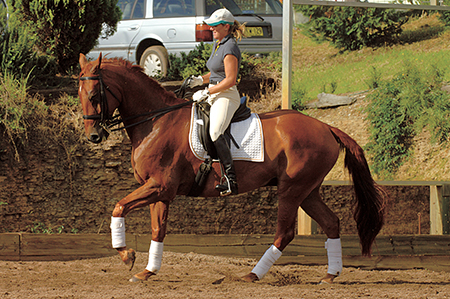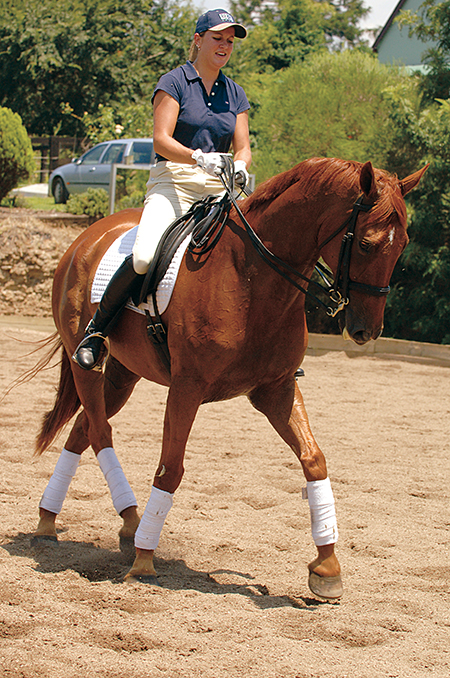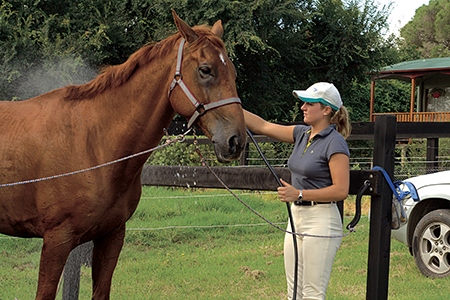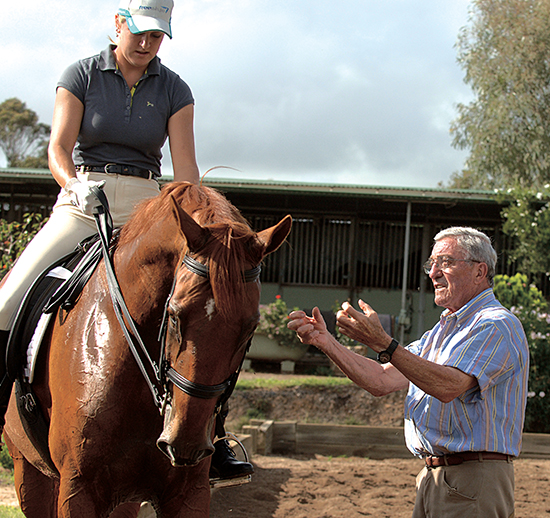 Story by Chris Hector and Photos by Roz Neave
Story by Chris Hector and Photos by Roz Neave
Now in his early seventies, Siegfried Peilicke – better known as ‘Bimbo’ – has long been one of Germany’s most respected dressage coaches, and even today his services are keenly sought by top competitive riders.
Bimbo worked for many years for the Linsenhof family, and learnt much from the great German master, Willi Schultheis. Bimbo trained many famous horses, perhaps the most successful of which was the great Dynasty, ridden by the Canadian, Cindy Ishoy.
He was for many years the coach of the German Junior Squad, and now freelances from his yard in Warendorf.
Lucky then are we Australians that Bimbo was impressed by the dedication of the young Australian rider, Glennis Scott, who arrived at his Warendorf training centre, some twenty two years ago.
Glennis, with Bimbo’s help, went on to compete at the World Dressage Championships in Canada in 1986, in the small tour, and then to become Australia’s first rider at a World Cup final in back in 1992. Now Glennis Barrey, Glennis’ long lasting friendship stands her in good stead, and Bimbo is a regular visitor to the GlennBarrey training centre at The Oaks, in NSW.
It is I suppose one of the most puzzling things about the whole business of riding that some people ‘get’ it, and some don’t. That no matter how hard some people try, they never get better, while others are naturals. I guess part of the puzzle is that the message is deceptively simple.
Let’s listen to Bimbo for a while. He’s not happy because the horse he is working with is going too fast forward but at the same time, you can’t grab its head to slow it down, because he wants its nose further out:
“Half halt. He’s running, don’t let him run away. Let go again, his nose is too far behind the vertical, give and half halt. The horse runs away and he comes too low, drive him a bit up to the bridle but not so he runs away and GIVE! His nose is too far behind the vertical. Half halt. Give.”
“The nose must be in front of the vertical. Up and out. As soon as he rolls behind, you have to correct it.”
Watching this inter-action it occurs to me that part of the popularity of the ‘behind the vertical deep and low’ current fashion is because it is a lot easier to do, just drive them into the contact and roll them over and keep them there… Getting the delicate balance right so the horse reaches up and forward is a lot harder. That’s why they reward you when you can do it in a dressage test and take points off when the horse goes behind the vertical.
So you can’t use your hands to slow down, what about your back? No go again.
“Your upper body is too stiff – it must be relaxed and supple. Always use a little half halt because he starts to get too free and run.”
And in the middle of all this, trying to make sense of what seem contradictory demands is twenty year old, Belinda and seven year old Daveson – her Stockhorse, Warmblood, Thoroughbred cross gelding.
In fact, the Master’s demands start even sooner than that, like the first second she walks into the arena…
“On the buckle Belinda, the worst thing you can do is get on the horse and take up the reins and go no-where. It’s just nothing – you’re riding the walk away…”
“When they first get on the horse, riders want to grab the horse’s head and soon there is no walk, let go the rein and ride the horse on the buckle.”
But the invitation to give the horse the longest possible rein is not an invitation for the rider to slack off.
“Even on the buckle you have to ride, not just dawdle around. There now… there you have some over-track, now you can take up the reins and warm up in working trot – make sure there are a few changes of tempo, but DON’T run.”
“Bend a little, straighten a little, and he starts to loosen in the poll. Ride lots of changes of direction, small circles, big circles. Collect a little, the rein must not be so long that you lose the connection – always find a good cadenced rhythm, the most expressive rhythmic trot – don’t let the horse run.”
Now the transition to canter – first in sitting trot make the horse loose in the poll, and then canter:
“But vary the rhythm in canter so he comes loose and more on the aids, bend him a bit, collect him a bit, but not so much that you lose the canter… now out!”
And again, Belinda was having problems with the horse’s head…
“Not so much behind the vertical, hands soft and push up to the bridle…”
And we are reminded of Bimbo’s observation on an earlier trip that only in Australia do riders go round and round and round and round like a washing machine:
“You’ve already done four circles, you must not ride the same thing over and over. And don’t just ride round and round the track, vary the size of the circle, vary the tempo of the canter. Canter to trot to canter, shoulder-in in trot to canter – and half halt when he runs.”
“You must have the hind legs following the front legs or you won’t get any bend through the rib-cage.”
“Now walk and let him stretch, give the rein, on the buckle, and walk one lap each way to give him a break. Now you have an over-track in the walk!”
Back to trot, Bimbo was still unhappy with the horse rolling over:
“He comes too low, get rid of the hand, use the snaffle not the curb, and every time he comes too low, give the rein, and give him a little kick. Drive up and out, don’t try to get him up with the hand, use the seat and leg so he comes up to the bridle. If you try to do it with your hand, he instantly drops his head. GIVE GIVE GIVE – push him up to the bridle, give him a kick with both legs until he brings his poll up. Then soft hands and little quick half halts if he runs away.”
There is work on the lateral movements, shoulder in and half pass, then it is back to that big relaxing walk:
“In the old days the master trainers were quite strict. You ride walk, then trot, then canter, and always with a proper walk in between, and then the work was done. Ride a few movements, walk, pick up the rein again, ride a few movements, and back on the buckle again. Every time you pick up the rein, you put on pressure, and as the movements become harder, more pressure, in between it is better to walk the pressure away.”
Now into the canter, Belinda still had a balancing act:
“Now a little collection in canter, not with the hands, don’t be so rough.”
And once again, Belinda was to work on the half passes:
“When you ride the half pass for the first time, leave the horse straight, even flex him to the outside. On the first half pass you just want to get sideways, moving from the outside rein and leg. When you have that sideways movement, then you can put the bend on.”
Later, I discussed the issues with Bimbo, remarking that it was hard that on the one hand the horses were not allowed to run, but on the other hand, they had to be engaged. They had to be up – but at the same time, the rider had to give. Did this mean that the horse had to be responding more to the seat of the rider?
“Whenever you give with the hand, you have to drive so that they come out to a contact. Not so you give the rein and it is loose – then they run. You have to ask them to step more forward with the hind legs so that you get the connection to the hand in the frame you wish for, not that you let the reins go and the hind legs are still going hodge podge behind. The contact is decided by the activity behind. You always have to have a connection between your hand and the horse’s mouth, and you only get that contact if you push the horse from your seat and leg into your hand. That relies on your feel – how much to give, how much to push.”
With Belinda, if you were going to work her for the next month – what program would you put her on?
“What she has to do, every day, is practice what we discussed. The riders tend to forget, and they don’t do the same next day, and the day after that… She has to get a much more consistent contact. It was too uneven today, too low, too light, too strong, high then down, it wasn’t consistent. The first thing she has to do is get the contact more consistent.”
“Her horse has the ability to do very good flying changes but she keeps disturbing the horse with her hands. In the second working session, even though her hands were moving, the horse stayed higher with the poll, in the first session he kept burrowing, so that was a considerable progression. Once she keeps her hands better, a lot of the tension will go from the horse. She has to discipline herself to keep her hands in the correct place. All the time, even in the walk, she has to look to her hands – look now she rides with open hands, she needs to close her hand, not clenched but closed because the reins keep going through her hands.”
Obviously in the current climate, there is the inevitable question – do you have any role for ‘Rolkur’ in your training system?
“No. There is no necessity for it. We ride them somewhat lower but it doesn’t have anything to do with rollkur. It is only long and low where the horse stretches, it is not a contained position. You always have to give the horse a chance to relax and stretch, you can’t put them instantly into a frame – if you try it on yourself, you will feel that your back is hollow – you just put the horse to the point where you feel the back can come up, then when you bring them more up towards your competition frame, then the horse will carry its neck and it will be loose to the left and the right.”
“When the horse goes well then rollkur is absolutely unnecessary. I have nothing against it in principle, but only very few riders have the skill to use it and end up with a desirable result. Anky is an example, if you watch her horses in a test, almost always the poll is a little bit low and the horse is behind the vertical. So when you see the result, then you can’t say that the method is suitable.”
I caught up with Belinda after she had put Dave away to get her impressions of the lessons, and find out more about her horse.
“I got him three years ago. He’s a Queensland horse – I come from the Gold Coast. Before I came to work with Heath and Rozzie Ryan at the NSW Centre, he had done a few novice tests. We’d never jumped before. I got him from a stud at Chinchilla – I actually helped break him in. The lady who owned him wanted a pony, and I still had my first pony, so it was a bit of a swap and then to pay the rest of him off, I went out and worked for her and rode her other horses.”
“Then I met a guy who had worked for Heath, and he gave me the number for the Centre. I didn’t know what I was getting myself into, I had no idea how it ran. I got the job at the Centre a little over two years ago.”
You must be tough to handle two years with Heath?
“I don’t know, it’s amazing there, I wouldn’t take any of it back. Just in the last two years, Dave and I have learnt so much and come so far…”
So what do you want to be an eventing star or a dressage queen?
“I really don’t know. At the moment I am having fun doing both. We are aiming to do Adelaide two star this year, and hopefully we’ll also do our first Prix St Georges as soon as we get enough points. I guess when the time comes I’ll decide which way I want to go. At the moment we are doing both.”
What were you aiming to get out of the lesson with Herr Peilicke?
“Just something to work on, what he said was exactly what I’ve been struggling with. It was what I needed to hear, hopefully I’ll go back and figure out how to do it.”
It’s very hard isn’t it, when he is saying I want the horse more up and out, but at the same time I don’t want the horse to rush forward…
“Dave is very sensitive with the leg as it is, and then to say to kick him, and then for him to not shoot off, is very difficult. For me, it is all mind blowing. I’m like oh my god what am I supposed to do?”
But it worked – more or less everything he told you to do, improved the way the horse went?
“Yeah, it did work. It was good I didn’t feel like I was getting frazzled at all, I just had to work through it, and I did sometimes get a feel for it but it was very hard for me to keep it. It feels amazing when he does come up there, he feels very soft – it’s nice but it is not easy to get.”
And after the second session with Herr Peilicke? That was hard work – poor Dave?
“Poor Dave, poor me, I think we are both having a bit of a clash of understanding but he felt a lot better in the second lesson. He started to understand what Herr Peilicke was trying to get me to do. I think like Glennis said, I need another year to do this work every day until I get to really establish it. Hopefully I can practice when I get home, and get it happening. I struggle so much to keep my hands still, and closed, and having them down on the wither was very difficult for me to do. And then to shorten the reins and get him up and keep him there, that was hard for me to do it all at once and keep it all together. All I can think of is ‘when can I come to another clinic with him?’ I loved it – it is what I needed to learn.”



